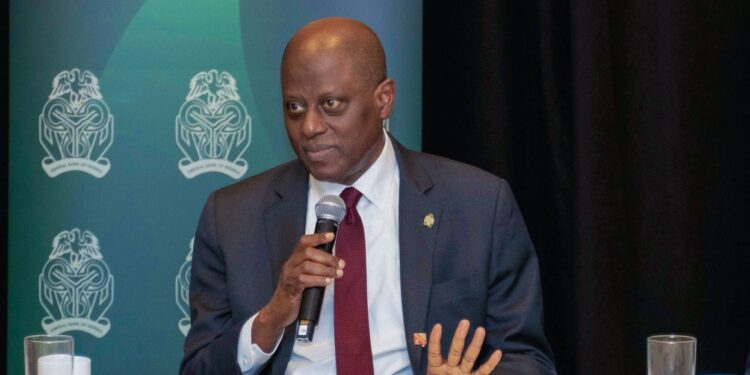The Central Bank jolted the market with a decision almost no one saw coming, choosing to hold the Monetary Policy Rate at 27% while keeping the liquidity ratio at 30% and maintaining steep Cash Reserve Requirements across the banking sector.
Analysts surveyed by Nairametrics had positioned for a cut, with some expecting a drop of up to 200 basis points, yet Governor Yemi Cardoso and his Committee opted for a firm freeze that seemed weird at first but ultimately blended caution, consolidation, and a quiet concern about deeper risks still roaming the economy.
Cardoso described the stance as necessary medicine for an economy that is only now showing clear signs that inflation is slowing.
The CBN’s forecast points to a steady cooling of price pressures driven by the delayed impact of aggressive tightening over the past year, supported by a foreign exchange market that has enjoyed several months of welcome stability.
As Cardoso stressed repeatedly, the priority is to “sustain the progress made so far toward achieving low and stable inflation,” which became the key theme of the announcement.
October’s inflation numbers backed his argument, showing a slowdown across headline, food, and core components. Still, the Committee believes these gains remain fragile and could easily reverse. The bank sees inflation trending lower, but it does not trust that the progress sits on firm ground, and protecting that improvement has become its overriding goal.
This explains why the MPC kept the benchmark rate at 27% while quietly adjusting the standing facility corridor, trimming the rate at which banks borrow from the CBN by 200 basis points and lowering the rate it pays banks for deposits by another 200 basis points. This is expected to ease pressure on banks without sending a wider signal that policy is softening.
The second major reason for holding rates came from outside Nigeria. Cardoso referenced “lingering global uncertainties” and indicated that the MPC would rather be cautious than stimulate at a moment when global risks remain unpredictable.
This suggests the Bank sees a mismatch between falling inflation figures and conditions in the real economy, where many businesses still complain about high operating costs. Inflation may be easing on paper, yet the impact has not fully reached factories, retailers, or service providers.
Is Money Supply a major factor?
Beneath the official explanations sits a more revealing concern. The Committee’s language around stability hints at a deeper unease over the size of the money supply, which has ballooned to more than N117 trillion as of October 2025.
Much of this excess liquidity came from years of heavy Ways and Means financing and various intervention funds that have been slow to return to the CBN. These funds continue to circulate in the economy and blunt the impact of higher interest rates, making the inflation fight more complicated than it appears.
The surge in net foreign assets—from N4.9 trillion to N34.8 trillion in one year—adds another warning sign. The jump reflects the sharp devaluation of the naira from about N750 to roughly N1,800 per dollar, which delivered huge windfalls to corporates and speculators holding foreign currency.
Those gains injected even more liquidity into the system, pushing the money supply further upward. Cutting rates now would be like opening another tap while the CBN is still struggling to close the first.
The recent strengthening of the naira owes much to strict liquidity control and the high yields offered on OMO bills, which currently sit near 22%.
Any move to cut the benchmark rate could weaken one of the few tools that have consistently supported FX stability, especially at a time when foreign investors are still very sensitive to returns.
The MPC appears more focused on protecting the fragile stability in the FX market than on offering cheaper borrowing conditions to firms or households.
What this means for borrowers
For borrowers hoping for lower interest rates, the news is not encouraging. Despite statements about supporting the real economy, the CBN seems willing to sacrifice short-term growth for price and currency stability.
Cardoso’s remarks on policy transmission show that the Bank believes previous rate hikes have not fully filtered through the economy, so it intends to wait for that process to run its course before taking any step toward easing.
This meeting revealed a central bank that is not ready to declare victory.
- Inflation is falling, but liquidity is still excessive.
- The naira is stronger, but global risks continue to cast a long shadow.
- The private sector is improving, but not enough to justify a move that could be read as complacency.
Seen in this context, the MPC’s decision to hold at 27% looks less surprising and more like a calculated attempt to avoid undoing months of progress.
For now, any real hope of a rate cut has been pushed into 2026. The earliest realistic window is the February meeting, assuming inflation keeps easing, liquidity pressures fall, and the global environment does not trigger another round of defensive action.
Until then, businesses will need to operate in a monetary climate that stays hawkish at the top level but slightly more flexible behind the scenes, creating a balancing act that may shape the next phase of Nigeria’s economic story.
In the end, the CBN’s move may look weird, but in a fragile economy wrestling with too much money and too many risks, weird might be exactly what is sensible.

















